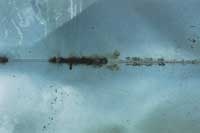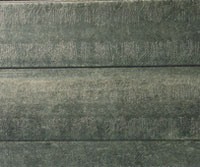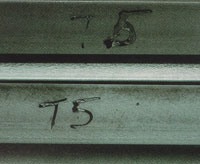S-T
Sand Embedded in Casting

Another type of surface defect occurs when sand becomes embedded in the castings and creates rough or bare spots on the surface of the galvanized steel. Sand inclusions are not removed by conventional acid chemical cleaning, so abrasive cleaning should be done at the foundry before the products are sent to the galvanizer. This type of defect also leaves bare spots and must be cleaned and repaired or the part must be rejected, stripped, and regalvanized. Sand embedded in a casting can be seen in Figure 43.
Zinc Skimmings

Oxidized zinc on the bath surface, zinc skimmings deposits, are usually caused when there is no access to remove the zinc skimmings during the withdrawal of the steel from the galvanizing kettle. Zinc skimmings on the molten zinc surface are then trapped on the zinc coating. Zinc skimming deposits (Figure 44) are not grounds for rejection as long as the zinc coating underneath is not harmed during their removal and it meets the necessary specifications. For aesthetic purposes, zinc skimmings can be brushed off the surface or will weather out after atmospheric exposure. Other zinc skimmings may need to be ground off the surface of the coating with care to avoid removing coating thickness underneath.
Striations

Striations are characterized by raised parallel ridges in the galvanized coating, mostly in the longitudinal direction. This can be caused when sections of the steel surface are more highly reactive then the areas around them. These sections are usually associated with segregation of steel impurities, especially phosphorous, created during the rolling process in steel making. Striations, as seen in Figure 45, are related to the type of steel galvanized and while the appearance is affected, the performance of the corrosion protection is not. Striations are acceptable on most parts; however, if the striations happen to occur on handrails, then the parts must be rejected and regalvanized. Sometimes regalvanizing does not improve the striations and the handrail must be refabricated out of better quality steel.
Surface Contaminant

When surface contaminants create an ungalvanized area where the contaminant was originally applied, a surface defect may occur. This is caused by paint, oil, wax, or lacquer not removed during the pretreatment cleaning steps. Surface contaminants, as seen in Figure 46, should be mechanically removed prior to the galvanizing process. If they result in bare areas, then the repair requirements apply and small areas may be repaired, but a large area is grounds for rejection and the entire part must be regalvanized.
Touch Marks

Another type of surface defect is known as touch marks, which are damaged or uncoated areas on the surface of the product. Touch marks are caused by galvanized products resting on each other or by the material handling equipment used during the galvanizing operation. Touch marks, as seen in Figure 47, are not cause for rejection if they meet the size criteria for repairable areas. They must be repaired before the part is accepted.